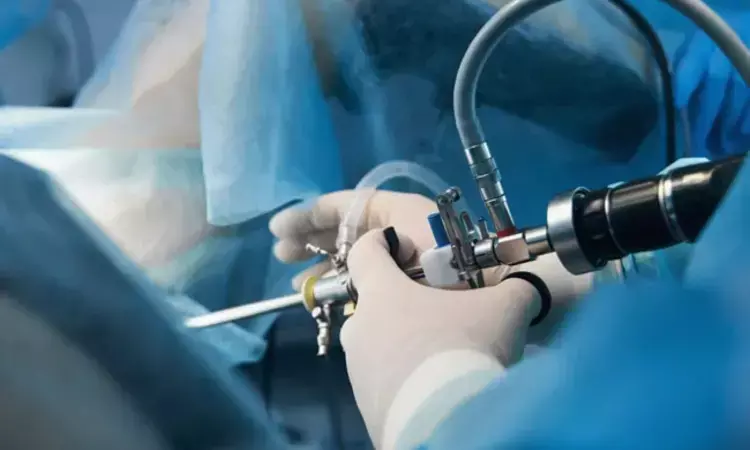- Home
- Medical news & Guidelines
- Anesthesiology
- Cardiology and CTVS
- Critical Care
- Dentistry
- Dermatology
- Diabetes and Endocrinology
- ENT
- Gastroenterology
- Medicine
- Nephrology
- Neurology
- Obstretics-Gynaecology
- Oncology
- Ophthalmology
- Orthopaedics
- Pediatrics-Neonatology
- Psychiatry
- Pulmonology
- Radiology
- Surgery
- Urology
- Laboratory Medicine
- Diet
- Nursing
- Paramedical
- Physiotherapy
- Health news
- Fact Check
- Bone Health Fact Check
- Brain Health Fact Check
- Cancer Related Fact Check
- Child Care Fact Check
- Dental and oral health fact check
- Diabetes and metabolic health fact check
- Diet and Nutrition Fact Check
- Eye and ENT Care Fact Check
- Fitness fact check
- Gut health fact check
- Heart health fact check
- Kidney health fact check
- Medical education fact check
- Men's health fact check
- Respiratory fact check
- Skin and hair care fact check
- Vaccine and Immunization fact check
- Women's health fact check
- AYUSH
- State News
- Andaman and Nicobar Islands
- Andhra Pradesh
- Arunachal Pradesh
- Assam
- Bihar
- Chandigarh
- Chattisgarh
- Dadra and Nagar Haveli
- Daman and Diu
- Delhi
- Goa
- Gujarat
- Haryana
- Himachal Pradesh
- Jammu & Kashmir
- Jharkhand
- Karnataka
- Kerala
- Ladakh
- Lakshadweep
- Madhya Pradesh
- Maharashtra
- Manipur
- Meghalaya
- Mizoram
- Nagaland
- Odisha
- Puducherry
- Punjab
- Rajasthan
- Sikkim
- Tamil Nadu
- Telangana
- Tripura
- Uttar Pradesh
- Uttrakhand
- West Bengal
- Medical Education
- Industry
Study Questions Necessity of Early Hysteroscopy After Suction D&C Despite Early Detection of Intrauterine Lesions

Taiwan: A recent randomized controlled trial has shed light on the efficacy of early office hysteroscopy in preventing intrauterine adhesions after abortion.
The study, published in BMC Women's Health, suggests that early office hysteroscopy following well-monitored suction dilatation and curettage (D&C) with intraoperative sonography may not be necessary. Furthermore, early hysteroscopy allowed early detection of intrauterine lesions (IUA).
"It's important to highlight that while the pregnancy outcomes showed a positive trend in the early hysteroscopy group, there were no statistically significant differences observed," the researchers wrote.
Intrauterine adhesions, commonly known as Asherman's syndrome, are a challenging clinical problem in reproductive infertility. The most common causes are abortions and intrauterine surgery. Kuo-Chung Lan, Kaohsiung Medical University, Kaohsiung, Taiwan, and colleagues aimed to investigate whether early second-look office hysteroscopy can prevent IUA.
To explore the efficacy of early office hysteroscopy after first-trimester induced abortion suction D&C and to further analyze fertility outcomes, the researchers designed a single-center, prospective, two-armed, randomized controlled trial. It recruited women aged 20–45 years undergoing suction D&C and desiring to conceive.
Sixty-six women were enrolled between 2019 and 2022, of whom 33 were allocated to group A (early hysteroscopy intervention). Women in intervention group A were scheduled for two hysteroscopies (early and late), while women in group B underwent only one late hysteroscopy, six months after the suction D&C.
The primary outcome was the rate of intrauterine adhesions, evaluated through office hysteroscopy six months after the artificial abortion. Secondary outcomes included menstrual volume and duration, as well as fertility outcomes.
The study led to the following findings:
· In intervention group A, 31 women underwent the first hysteroscopy examination, and 15 completed the second.
· In group B (late hysteroscopy intervention, 33 patients), 16 completed the hysteroscopic exam six months after an artificial abortion.
· Twenty-one women did not receive late hysteroscopy due to pregnancy.
· The IUA rate was 16.1% (5/31) at the first hysteroscopy in group A, and no IUA was detected during late hysteroscopy.
· Neither group showed statistically significant differences in the follow-up pregnancy and live birth rates.
The researchers concluded that early hysteroscopy after suction D&C can identify intrauterine lesions. Intrauterine adhesions detected early through hysteroscopy may resolve by the time of later examinations, becoming insignificant for future pregnancies. While pregnancy outcomes showed a positive trend in the early hysteroscopy group, we found no statistically significant differences.
"Further studies could investigate the role of hysteroscopy and hyaluronic gel following multiple suction D&Cs and/or medical abortions. This preliminary report may catalyze others to explore and validate these findings," they wrote.
Reference:
Tsai, NC., Hsiao, YY., Su, YT. et al. The efficacy of early office hysteroscopy in preventing intrauterine adhesions after abortion: a randomized controlled trial. BMC Women's Health 24, 400 (2024). https://doi.org/10.1186/s12905-024-03247-0
Dr Kamal Kant Kohli-MBBS, DTCD- a chest specialist with more than 30 years of practice and a flair for writing clinical articles, Dr Kamal Kant Kohli joined Medical Dialogues as a Chief Editor of Medical News. Besides writing articles, as an editor, he proofreads and verifies all the medical content published on Medical Dialogues including those coming from journals, studies,medical conferences,guidelines etc. Email: drkohli@medicaldialogues.in. Contact no. 011-43720751


